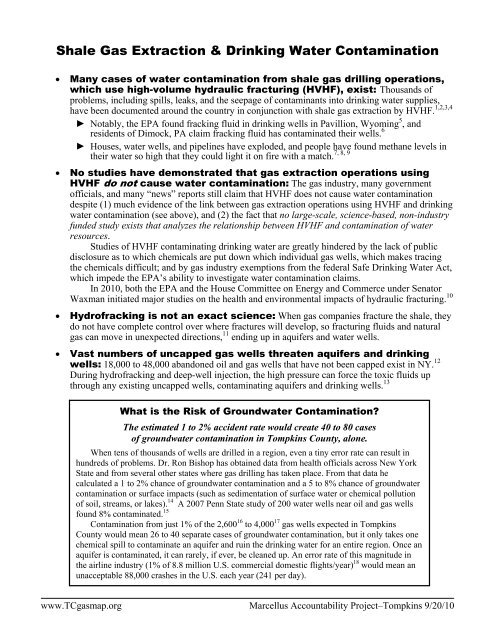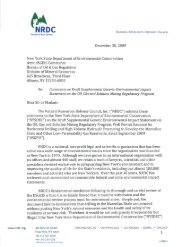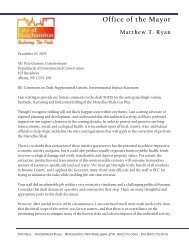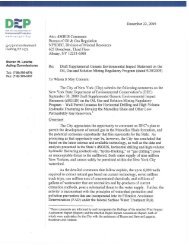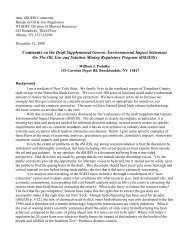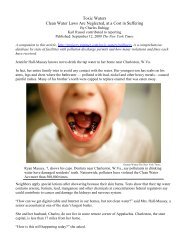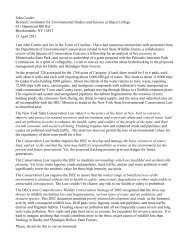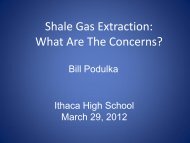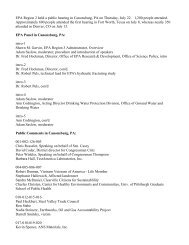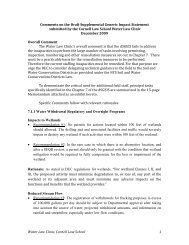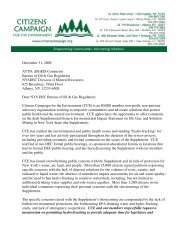Shale Gas Extraction & Drinking Water ... - MAP–Tompkins
Shale Gas Extraction & Drinking Water ... - MAP–Tompkins
Shale Gas Extraction & Drinking Water ... - MAP–Tompkins
You also want an ePaper? Increase the reach of your titles
YUMPU automatically turns print PDFs into web optimized ePapers that Google loves.
<strong>Shale</strong> <strong>Gas</strong> <strong>Extraction</strong> & <strong>Drinking</strong> <strong>Water</strong> Contamination<br />
• Many cases of water contamination from shale gas drilling operations,<br />
which use high-volume hydraulic fracturing (HVHF), exist: Thousands of<br />
problems, including spills, leaks, and the seepage of contaminants into drinking water supplies,<br />
have been documented around the country in conjunction with shale gas extraction by HVHF. 1,2,3,4<br />
► Notably, the EPA found fracking fluid in drinking wells in Pavillion, Wyoming 5 , and<br />
residents of Dimock, PA claim fracking fluid has contaminated their wells. 6<br />
► Houses, water wells, and pipelines have exploded, and people have found methane levels in<br />
7, 8, 9<br />
their water so high that they could light it on fire with a match.<br />
• No studies have demonstrated that gas extraction operations using<br />
HVHF do not cause water contamination: The gas industry, many government<br />
officials, and many “news” reports still claim that HVHF does not cause water contamination<br />
despite (1) much evidence of the link between gas extraction operations using HVHF and drinking<br />
water contamination (see above), and (2) the fact that no large-scale, science-based, non-industry<br />
funded study exists that analyzes the relationship between HVHF and contamination of water<br />
resources.<br />
Studies of HVHF contaminating drinking water are greatly hindered by the lack of public<br />
disclosure as to which chemicals are put down which individual gas wells, which makes tracing<br />
the chemicals difficult; and by gas industry exemptions from the federal Safe <strong>Drinking</strong> <strong>Water</strong> Act,<br />
which impede the EPA’s ability to investigate water contamination claims.<br />
In 2010, both the EPA and the House Committee on Energy and Commerce under Senator<br />
Waxman initiated major studies on the health and environmental impacts of hydraulic fracturing. 10<br />
• Hydrofracking is not an exact science: When gas companies fracture the shale, they<br />
do not have complete control over where fractures will develop, so fracturing fluids and natural<br />
gas can move in unexpected directions, 11 ending up in aquifers and water wells.<br />
• Vast numbers of uncapped gas wells threaten aquifers and drinking<br />
wells: 18,000 to 48,000 abandoned oil and gas wells that have not been capped exist in NY. 12<br />
During hydrofracking and deep-well injection, the high pressure can force the toxic fluids up<br />
through any existing uncapped wells, contaminating aquifers and drinking wells. 13<br />
What is the Risk of Groundwater Contamination?<br />
The estimated 1 to 2% accident rate would create 40 to 80 cases<br />
of groundwater contamination in Tompkins County, alone.<br />
When tens of thousands of wells are drilled in a region, even a tiny error rate can result in<br />
hundreds of problems. Dr. Ron Bishop has obtained data from health officials across New York<br />
State and from several other states where gas drilling has taken place. From that data he<br />
calculated a 1 to 2% chance of groundwater contamination and a 5 to 8% chance of groundwater<br />
contamination or surface impacts (such as sedimentation of surface water or chemical pollution<br />
of soil, streams, or lakes). 14 A 2007 Penn State study of 200 water wells near oil and gas wells<br />
found 8% contaminated. 15<br />
Contamination from just 1% of the 2,600 16 to 4,000 17 gas wells expected in Tompkins<br />
County would mean 26 to 40 separate cases of groundwater contamination, but it only takes one<br />
chemical spill to contaminate an aquifer and ruin the drinking water for an entire region. Once an<br />
aquifer is contaminated, it can rarely, if ever, be cleaned up. An error rate of this magnitude in<br />
the airline industry (1% of 8.8 million U.S. commercial domestic flights/year) 18 would mean an<br />
unacceptable 88,000 crashes in the U.S. each year (241 per day).<br />
www.TCgasmap.org Marcellus Accountability Project–Tompkins 9/20/10
Endnotes:<br />
1 A listing of many news reports and studies of contaminated water is posted at:<br />
http://www.tcgasmap.org/default.asp?metatags_Action=Find('PID','8')#<strong>Water</strong> Contamination<br />
2 McConnell, S. Sept. 22, 2009. “Third Natural <strong>Gas</strong> Chemical Spill Reported.” The Wayne Independent.<br />
http://www.wayneindependent.com/news/x1699593258/Third-natural-gas-chemical-spill-reported<br />
3 Lustgarten, A. November 13, 2008. “Buried Secrets: Is Natural <strong>Gas</strong> Drilling Endangering U.S. <strong>Water</strong><br />
Supplies?” ProPublica. http://www.propublica.org/feature/buried-secrets-is-natural-gas-drilling-endangeringus-water-supplies-1113<br />
4 Thyne, G. December 20, 2008. “Review of Phase II Hydrogeologic Study.” (Report prepared for Garfield<br />
County, Colorado.) http://s3.amazonaws.com/propublica/assets/methane/thyne_review.pdf<br />
5 Lustgarten, A. Sept. 1, 2010. “Feds Warn Residents Near Wyoming <strong>Gas</strong> Drilling Sites Not to Drink Their<br />
<strong>Water</strong> .” ProPublica. http://www.propublica.org/article/feds-warn-residents-near-wyoming-gas-drilling-sitesnot-to-drink-their-wate<br />
6<br />
Rubinkam, Michael & Mary Esch. Sept. 15, 2010. “Lawsuit: <strong>Gas</strong> Drilling Fluid Ruined PA <strong>Water</strong> Wells.”<br />
Philly.com, Business.<br />
http://www.philly.com/philly/wires/ap/business/20100915_ap_lawsuitgasdrillingfluidruinedpawaterwells.html<br />
7 Lustgarten, A. July 31, 2009. “<strong>Water</strong> Problems From Drilling Are More Frequent Than PA Officials Said.”<br />
ProPublica. http://www.propublica.org/feature/water-problems-from-drilling-are-more-frequent-than-officialssaid-731<br />
8 Lustgarten, A. April 22, 2009. “Colorado Study Links Methane in <strong>Water</strong> to Drilling.” ProPublica.<br />
http://www.propublica.org/feature/colorado-study-links-methane-in-water-drilling-422<br />
9 See http://vimeo.com/4680635 for a video of a homeowner lighting his tap water on fire.<br />
10 See http://www.tcgasmap.org/default.asp?metatags_Action=Find('PID','8')#Legislative Issues and<br />
http://www.tcgasmap.org/media/Scoping Document for EPA Hydraulic Fracturing Study 4-1-10.pdf<br />
11 Quotes from industry research scientists on the uncertainty in hydraulic fracturing:<br />
http://www.tcgasmap.org/media/Hydraulic Fracturing Predicting Difficulties Industry Source.pdf<br />
12 Interstate Oil and <strong>Gas</strong> Compact Commission. September 1994. “IOGCC/EPA Review of Oil and <strong>Gas</strong><br />
Exploration and Production Waste Management Regulatory Programs: New York State Review.”<br />
http://www.strongerinc.org/documents/New York Initial Review 9–1994.pdf (See p. 42)<br />
13 http://splashdownpa.blogspot.com/2009/10/letter-from-wilma-subra-to-new-york.html<br />
(See “A Letter from Wilma Subra to New York State,” and the section titled “Hydraulic Fracturing.”)<br />
14 Dr. Ron Bishop, private communication. Officials were asked about incidents of groundwater contamination and<br />
surface problems (chemical pollution of soil, sedimentation, and similar issues).<br />
15 Clark, J., B. R. Swistock, and S. Clemens. 2007. Unpublished data collected from 200 private water wells in<br />
McKean County, noted in: http://resources.cas.psu.edu/<strong>Water</strong>Resources/pdfs/gasdrilling.pdf<br />
16 The recent prediction of there being a 50% chance of 489 trillion cubic feet of gas being produced over 50 years<br />
from the entire Marcellus <strong>Shale</strong> [Engelder, T. 2009. Marcellus 2008: Report Card on the Breakout Year for <strong>Gas</strong><br />
Production in the Appalachian Basin. Fort Worth Basin Oil & <strong>Gas</strong> Magazine] requires a well pad every square<br />
mile with 8 wells per pad over 70% of the Marcellus shale formation. This scenario results in 2,600 wells for<br />
Tompkins County, alone. [Tompkins County total land area = 305,250 acres; 70% of this is 213,675 acres.<br />
Assuming a well pad with 8 wells every square mile (640 acres) results in 2,600 wells.]<br />
17 No hard figures exist for the number of wells that will be drilled. Administrators in Tompkins County expect<br />
4,000 wells. See the draft SGEIS comments by the Tompkins County Planning Dept.<br />
http://www.tcgasmap.org/media/Town of Ithaca Comments on Draft SGEIS.pdf<br />
18 http://www.bts.gov/press_releases/2009/bts058_09/html/bts058_09.html#table_07<br />
(See Table 7: 6,630,500 flights in the first 9 months of 2009 translates to 8.8 million per year.)


